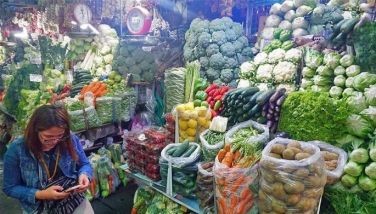Rice inflation

Technically, “rice inflation” is not an economic phrase. In a major rice consuming country like the Philippines, which regularly relies on importations, the term is relevant although has not been used for some time now after the Rice Tariffication Law was passed in 2019 to help stabilize rice prices and improve the country’s agricultural sector.
The law has its limitations, of course, just as with many other laws. As a potent tool in controlling rice prices, though, the law’s effectiveness depends on various factors, including global rice market dynamics, trade policies, weather conditions, and the government’s ability to manage the overall agricultural sector.
This year, rice prices started creeping upwards. Data from the Philippine Statistics Authority (PSA) reflected a steady increase in rice prices starting at 2.6 percent in March, then 2.9 percent in April, 3.4 percent in May, 3.6 percent in June, before hitting 4.2 percent last month.
At a time when the country’s inflation levels are trending downwards to 4.7 percent last month after a high of 8.7 percent earlier in January, prices of rice, corn, vegetables, and certain foods that are a staple of many Filipinos’ diet are going the other way.
The Department of Agriculture (DA) has explained that the recent increase in rice prices is related to the higher cost of fuel and fertilizers, which has resulted in the current farmgate price of rice of between P19 to P21 per kilo from a previous P16 to P17/k.
What this may simplistically mean is that the government’s subsidies to rice farmers are not enough to offset the higher prices of farming inputs, or that the allocated money are not reaching the intended beneficiaries. Either way, the DA must ensure that sufficient government funds are released immediately when the farmers need them.
Managing trade ‘play’
The other reason cited as among the reasons for the upward trend in rice prices was the earlier reaction of traders to a possible increase in rice importations, and recently, to alarming developments affecting both rice and corn exports from major grain producing countries.
India recently announced that it would restrict exports of non-basmati white rice to lower its domestic prices and ensure adequate supply for its own people. Devastating floods in Pakistan last year tightened rice supply, and India is factoring in the possible effect of the El Niño weather pattern spilling over to its agricultural sector.
The surprise ban on rice exports immediately sent prices in the global market higher since India accounts for about 40 percent of the world’s rice trade. Other countries aside from the Philippines that rely on Indian rice exports are Malaysia, Vietnam, Nigeria, Ivory Coast, and Senegal.
Such move is regarded as speculative since no one really knows for sure what will happen in the next months, even with the warned El Niño effects. However, India has little option but to take a conservative view, being the second biggest rice consumer next to China. Incidentally, both countries have the highest populations in the world at about 1.4 billion each.
Corn, which is a feed material for our poultry and hog raising industries, has also seen some speculative price hikes after Russia suspended the Ukraine Black Sea grain export agreement. The move is expected to bring corn import prices up by 10 to 15 percent this year.
How both these developments will weigh on inflation in the coming months is being closely monitored. However, more measures must be considered to ensure that any triggers to higher rice prices will be mitigated with effective measures.
This includes ensuring that speculators that prey on the uncertainties of the current situation are held at bay. We’ve seen how their shenanigans have led to abnormally high prices of sugar, and while Filipinos can forgo their sugar fix, most cannot live without rice.
Committing to self-sufficiency
The Rice Competitive Enhancement Fund (RCEF), an offshoot of the Rice Tariffication Law of 2019, needs a comprehensive audit and report. Not only do we need to gauge its effectiveness, but also to ensure that the tens of billions of pesos allocated by law yearly have been put to productive use.
The government must also put an end to the debate on whether the country should be contented with having a “small” deficit in domestic rice supply and rely on importation yearly, or to go all-out and ensure that local production will be more than sufficient to meet the demands of a growing nation.
Too many risks are already exposing the country’s food supply vulnerability. Rice continues to be a sensitive commodity given that it is a staple in the Filipino diet and household spending.
Economists might regard the drive for rice self-sufficiency as a cost that would entail unnecessary investments, given the country’s other priorities, and this thinking may need to be reviewed if we truly want to secure even just our rice needs.
Dealing with climate change
Already, it is not just a question of improving farm productivity and opening up new rice lands. The more pressing concern is climate change, which does not just affect the Philippines, but also big rice producing and exporting countries like India, Thailand, Indonesia, and Vietnam.
Droughts and floods have worsened with increased frequency that they have become new reasons for recent food supply chain disruptions. The Philippines’ increasing reliance on and need for imported foods should set off warning bells and should be tackled seriously.
We are living in a world where the old norms are being replaced with new ones that scream of unpredictability. Part of our disaster preparedness must increasingly reckon with this.
Facebook and Twitter
We are actively using two social networking websites to reach out more often and even interact with and engage our readers, friends and colleagues in the various areas of interest that I tackle in my column. Please like us on www.facebook.com/ReyGamboa and follow us on www.twitter.com/ReyGamboa.
Should you wish to share any insights, write me at Link Edge, 25th Floor, 139 Corporate Center, Valero Street, Salcedo Village, 1227 Makati City. Or e-mail me at [email protected]. For a compilation of previous articles, visit www.BizlinksPhilippines.net.
- Latest
- Trending




























